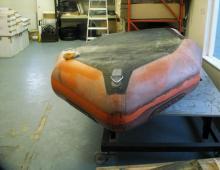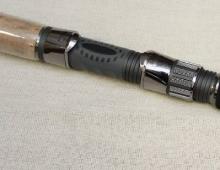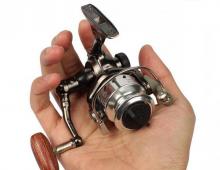Homemade anchors. Drawings and designs. Folding cat. Anchor weight and rope size.
How to determine the weight of the anchor and the dimensions of the anchor line.
It makes no sense to carry a heavy Admiralty anchor on a light boat, but it will be even worse if you go out to sea on a cabin boat with a three-kilogram “cat”. It is clear that in the first case a useful place will be occupied in vain, in the second the most sad consequences are possible.
Let's better estimate what kind of anchor the ship really needs, using approximate formulas.
Anchor weight
W =(8÷10)(3rd root of D 2 ) kgf,
D-vessel displacement, tf.
Anchor chain gauge (link rod diameter)
d \u003d 4.7 (3rd root of D) mm.
Table 1. Anchors and ropes for boats and motor boats
The diameter of a rope made of less durable than kapron, sisal cable should be approximately doubled, of hemp - three times. Comparative data of plant and nylon cables are given in tab. 3.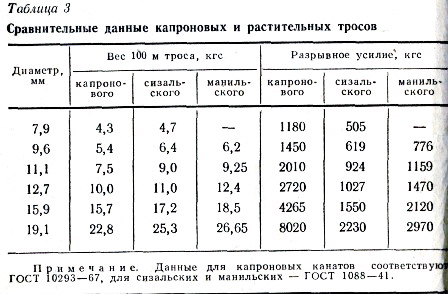
Do not forget that the breaking load of the anchor line should be 40-50 times the weight of the anchor specified in tab. one And table 2.
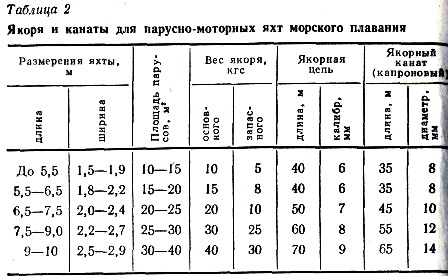
How many anchors do you need?
This question usually arises before the captains of relatively large boats and yachts intended for long-distance voyages,
It is considered necessary to have on board a second anchor (it can be 20-30% lighter than the main one) and a small (5 kgf) boat anchor or cat. It is desirable that each anchor is equipped with its own rope.
Which anchor is best?
Definitely do not answer this question.
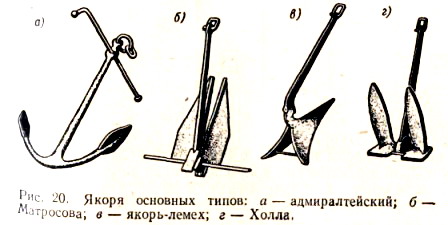
Admiralteisky (Fig. 20) in terms of holding power, it is 3-4 times inferior to anchors that cling to the bottom with not one, but simultaneously with two paws (for example, the Hall anchor), but the reliability of the anchorage is less, depending on the nature of the soil. The Hall anchor, when the rope is pulled, often turns out due to the heterogeneity of the soil under both paws, so it is risky to take it easier than the Admiralty.
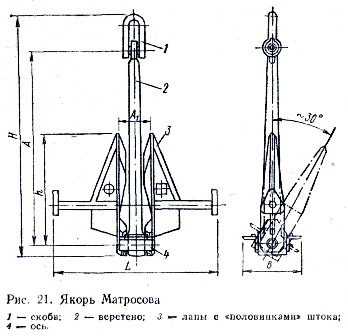 When purchasing an Admiralty anchor, make sure it is properly made: the spindle and stem must be at least 2.5 times the length of each horn. As a rule, anchors of this type with a longer spindle have better holding power.
When purchasing an Admiralty anchor, make sure it is properly made: the spindle and stem must be at least 2.5 times the length of each horn. As a rule, anchors of this type with a longer spindle have better holding power.
An ordinary four-legged cat is successfully used on river boats and boats; to increase its reliability, it is recommended to fix an additional load on the spindle.
For large boats and yachts, the Matrosov anchor is recommended (Fig. 21). This is an anchor with increased holding power. Matrosov's anchors are produced (little welded) with a weight starting from 5 kgf, which makes it possible to choose them for almost all inland navigation vessels. However, we note that for the safety of the parking it is still better to have a heavy Admiralty anchor, and not a lighter anchor of increased holding power. table
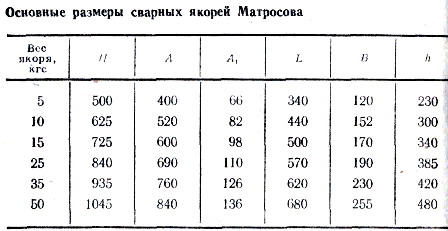
Washer instead of checks.
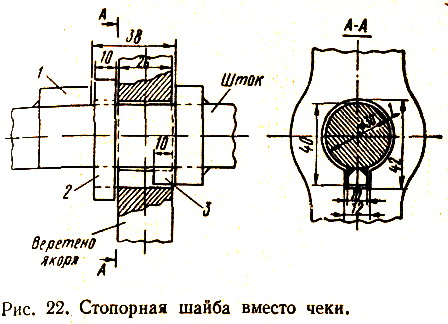 On a standard Admiralty anchor, the rod is fixed in the working position with an adjustable pin. It is not comfortable.
On a standard Admiralty anchor, the rod is fixed in the working position with an adjustable pin. It is not comfortable.
Instead of a check, you can use a lock washer with a groove ( rice. 22). A spike 1 is welded onto the rod, which passes through the corresponding rectangular groove on the washer 2, loosely put on the part of the rod passing through the spindle. It is enough to turn the washer, sliding it close to the spindle, and the stem will be fixed. And so that the stem does not rotate, a second such spike is made on it 3, included in the corresponding groove of the hole in the spindle.
Homemade welded anchor Kurbatov.
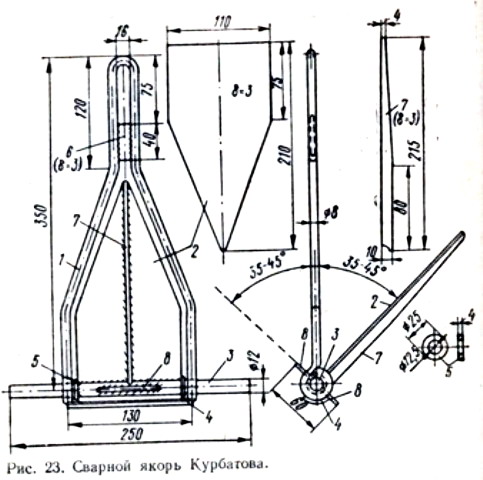 Welded anchor (Fig. 23) can be made from wire with a diameter of 8 mm, a piece of 12 mm rod and sheet steel 3 mm thick. It resembles the well-known anchors of Danforth and Matrosov, but differs from them in that it has only one paw and a forked spindle. The anchor of the dimensions indicated on the drawing weighs about 2.5 kgf and can be used on rowing and motor boats Mina up to 5 m. It holds well on most soils, but in order to increase its reliability on rocky soils, where weight is primarily important, it is recommended to have in stock is a blank weighing 3-4 kgf, which can be put on the anchor end and lowered along with the anchor.
Welded anchor (Fig. 23) can be made from wire with a diameter of 8 mm, a piece of 12 mm rod and sheet steel 3 mm thick. It resembles the well-known anchors of Danforth and Matrosov, but differs from them in that it has only one paw and a forked spindle. The anchor of the dimensions indicated on the drawing weighs about 2.5 kgf and can be used on rowing and motor boats Mina up to 5 m. It holds well on most soils, but in order to increase its reliability on rocky soils, where weight is primarily important, it is recommended to have in stock is a blank weighing 3-4 kgf, which can be put on the anchor end and lowered along with the anchor.
The spindle 1 is bent from wire; a bar is welded in its upper part 6. To stock 3 (does not require any machining) fixing washers 5 and strips must be welded 8, which, when the anchor 1 falls to the bottom, turn the paw 2 and force it to sink into the ground. The rod for stability of the anchor on the ground must have a length not less than that indicated on the drawing.
The ends of the spindle at the stem are connected by a strip 4, which simultaneously limits the angle of rotation of the paw: bar 8 rests against it and holds the paw in the working position. Rib 7 is welded to the paw.
Anchor Trident.
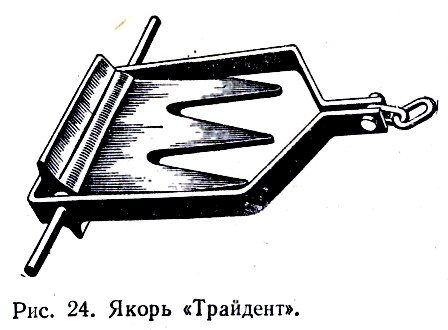 In recent years, the single-legged Trident anchor has been used abroad. (Fig. 24), which differs little in design from the Kurbatov anchor,
In recent years, the single-legged Trident anchor has been used abroad. (Fig. 24), which differs little in design from the Kurbatov anchor,
The paw of the Trident anchor is wider and has the shape of a trident, so it holds well on soft and loose ground (sand, silt, pebbles). On clay and rocky soil, ballast must be added. A crest is made across the entire width of the paw, which turns it when the anchor crawls along the bottom; thanks to the rotation, the paw “bites” into the ground. At the same time, the comb, resting against the lower strip of the anchor clip, limits the rotation of the paw to a certain angle (about 40 °).
"Trident" weighing 2 kgf (paw width 235 mm) is suitable for boats 3-4 m long, and with a weight of 7 kgf (paw width 375 mm) - for small boats and motor boats up to 6 m long.
Three designs of a folding cat.
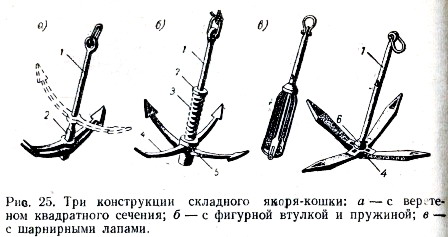 Four-legged cat anchors, which have become widespread on river boats, are inconvenient for storage on a ship. We recommend making a "folding" cat of one of those shown on rice. 25 structures.
Four-legged cat anchors, which have become widespread on river boats, are inconvenient for storage on a ship. We recommend making a "folding" cat of one of those shown on rice. 25 structures.
At the simplest (Fig. 25, a) cats the lower part of the spindle 1 is not round, but square 2. An appropriately shaped hole is made in the upper sleeve - a movable pair of paws. In order for all the paws to be in the same plane, you need to raise the movable pair of paws to the round section of the spindle, then, turning them 90 °, lower them back into place.
In another design (Fig. 25, b) upper movable pair of paws 4 fixed in working position thanks to a cutout in the sleeve 5. Washer welded to spindle 7, in which the spring rests 3, holding a pair of paws 4 in working or folded position.
The third design of a folding four-legged anchor (Fig. 25, in) , spread abroad, 1 differs in that all paws 4 fixed at the bottom; spindle parts 1 articulated. Coupling 6, sliding along the spindle, stops in the upper or lower position and, accordingly, fixes the paws in the folded along the spindle or in working condition.
In order not to lose the anchor.
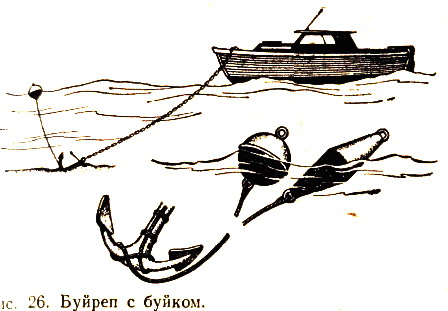 When sailing through reservoirs littered with snags and flooded trees, the likelihood of staying; very large without an anchor. Therefore, to anchor without tying to the trend (the junction of the horns with the spindle) a buoy with a buoy (Fig. 26), do not do it. It is best to have a buoy (it is called a tomb buoy) with a 10-15 m long buoy at all times in the ship's supply. In extreme cases, instead of a buoy, you can use any floating object - a wooden chock, a piece of foam, etc.
When sailing through reservoirs littered with snags and flooded trees, the likelihood of staying; very large without an anchor. Therefore, to anchor without tying to the trend (the junction of the horns with the spindle) a buoy with a buoy (Fig. 26), do not do it. It is best to have a buoy (it is called a tomb buoy) with a 10-15 m long buoy at all times in the ship's supply. In extreme cases, instead of a buoy, you can use any floating object - a wooden chock, a piece of foam, etc.

